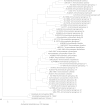A multilocus sequence typing scheme implies population structure and reveals several putative novel Achromobacter species
- PMID: 22785192
- PMCID: PMC3421806
- DOI: 10.1128/JCM.00814-12
A multilocus sequence typing scheme implies population structure and reveals several putative novel Achromobacter species
Abstract
The genus Achromobacter currently is comprised of seven species, including Achromobacter xylosoxidans, an opportunistic and nosocomial pathogen that displays broad-spectrum antimicrobial resistance and is recognized as causing chronic respiratory tract infection in persons with cystic fibrosis (CF). To enable strain typing for global epidemiologic investigations, to clarify the taxonomy of "Achromobacter-like" strains, and to elucidate the population structure of this genus, we developed a genus-level multilocus sequence typing (MLST) scheme. We employed in silico analyses of whole-genome sequences of several phylogenetically related genera, including Bordetella, Burkholderia, Cupriavidus, Herminiimonas, Janthinobacterium, Methylibium, and Ralstonia, for selecting loci and designing PCR primers. Using this MLST scheme, we analyzed 107 genetically diverse Achromobacter isolates cultured from biologic specimens from CF and non-CF patients, 1 isolate recovered from sludge, and an additional 39 strains obtained from culture collections. Sequence data from these 147 strains, plus three recently genome-sequenced Achromobacter strains, were assigned to 129 sequence types based on seven loci. Calculation of the nucleotide divergence of concatenated locus sequences within and between MLST clusters confirmed the seven previously named Achromobacter species and revealed 14 additional genogroups. Indices of association showed significant linkage disequilibrium in all of the species/genogroups able to be tested, indicating that each group has a clonal population structure. No clear segregation of species/genogroups between CF and non-CF sources was found.
Figures


Similar articles
-
Distribution of the species of Achromobacter in a French Cystic Fibrosis Centre and multilocus sequence typing analysis reveal the predominance of A. xylosoxidans and clonal relationships between some clinical and environmental isolates.J Cyst Fibros. 2016 Jul;15(4):486-94. doi: 10.1016/j.jcf.2015.12.009. Epub 2016 Jan 8. J Cyst Fibros. 2016. PMID: 26778615
-
Multilocus sequence analysis of isolates of Achromobacter from patients with cystic fibrosis reveals infecting species other than Achromobacter xylosoxidans.J Clin Microbiol. 2012 Aug;50(8):2688-94. doi: 10.1128/JCM.00728-12. Epub 2012 Jun 6. J Clin Microbiol. 2012. PMID: 22675125 Free PMC article.
-
Molecular characterization of Achromobacter isolates from cystic fibrosis and non-cystic fibrosis patients in Madrid, Spain.J Clin Microbiol. 2013 Jun;51(6):1927-30. doi: 10.1128/JCM.00494-13. Epub 2013 Mar 27. J Clin Microbiol. 2013. PMID: 23536401 Free PMC article.
-
Epidemic Achromobacter xylosoxidans strain among Belgian cystic fibrosis patients and review of literature.BMC Microbiol. 2016 Jun 24;16(1):122. doi: 10.1186/s12866-016-0736-1. BMC Microbiol. 2016. PMID: 27342812 Free PMC article. Review.
-
Achromobacter spp. prevalence and adaptation in cystic fibrosis lung infection.Microbiol Res. 2022 Oct;263:127140. doi: 10.1016/j.micres.2022.127140. Epub 2022 Jul 22. Microbiol Res. 2022. PMID: 35931003 Review.
Cited by
-
Duplex real-time PCR assay for the simultaneous detection of Achromobacter xylosoxidans and Achromobacter spp.Microb Genom. 2020 Jul;6(7):mgen000406. doi: 10.1099/mgen.0.000406. Epub 2020 Jul 15. Microb Genom. 2020. PMID: 32667877 Free PMC article.
-
Longitudinal Surveillance and Combination Antimicrobial Susceptibility Testing of Multidrug-Resistant Achromobacter Species from Cystic Fibrosis Patients.Antimicrob Agents Chemother. 2020 Oct 20;64(11):e01467-20. doi: 10.1128/AAC.01467-20. Print 2020 Oct 20. Antimicrob Agents Chemother. 2020. PMID: 32816722 Free PMC article.
-
Genomics and taxonomy of the glyphosate-degrading, copper-tolerant rhizospheric bacterium Achromobacter insolitus LCu2.Antonie Van Leeuwenhoek. 2024 Jul 23;117(1):105. doi: 10.1007/s10482-024-01989-3. Antonie Van Leeuwenhoek. 2024. PMID: 39043973
-
Chronic Airway Colonization by Achromobacter xylosoxidans in Cystic Fibrosis Patients Is Not Sustained by Their Domestic Environment.Appl Environ Microbiol. 2018 Nov 15;84(23):e01739-18. doi: 10.1128/AEM.01739-18. Print 2018 Dec 1. Appl Environ Microbiol. 2018. PMID: 30217850 Free PMC article.
-
Niches, population structure and genome reduction in Ochrobactrum intermedium: clues to technology-driven emergence of pathogens.PLoS One. 2014 Jan 17;9(1):e83376. doi: 10.1371/journal.pone.0083376. eCollection 2014. PLoS One. 2014. PMID: 24465379 Free PMC article.
References
-
- Aisenberg G, Rolston KV, Safdar A. 2004. Bacteremia caused by Achromobacter and Alcaligenes species in 46 patients with cancer (1989–2003). Cancer 101:2134–2140 - PubMed
-
- Coenye T, et al. 2003. Kerstersia gyiorum gen. nov., sp. nov., a novel Alcaligenes faecalis-like organism isolated from human clinical samples, and reclassification of Alcaligenes denitrificans Ruger and Tan 1983 as Achromobacter denitrificans comb. nov. Int. J. Syst. Evol. Microbiol. 53:1825–1831 - PubMed
-
- Coenye T, Vancanneyt M, Falsen E, Swings J, Vandamme P. 2003. Achromobacter insolitus sp. nov. and Achromobacter spanius sp. nov., from human clinical samples. Int. J. Syst. Evol. Microbiol. 53:1819–1824 - PubMed
Publication types
MeSH terms
Substances
LinkOut - more resources
Full Text Sources
Molecular Biology Databases

